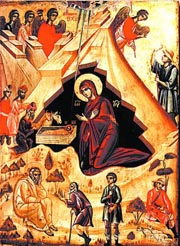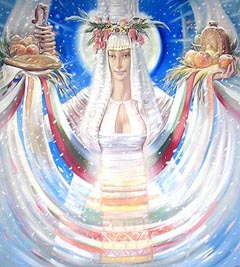Natural phenomena played an important part in the life of the Bulgarian folk. By watching the birds farmers distinguished the seasons. As soon as swallows and storks returned they knew that spring had come. Later, after all migratory birds were back to the countryside the peasants knew that Saint George’s day was at hand. Saint Peter’s day was recognized by the absence of the cuckoo’s song. The departure of storks suggested that Saint Pantheleimon’s Day [July 27th] is near. Swallows leave about the time of The Elevation of the Holy Cross [September 14th]. Migratory birds are gone by Saint Demetrius’ day [October 26th].
The dates of the religious holidays follow the Julian calendar, which is thirteen days behind the Gregorian calendar. Although in 1968 the Bulgarian Eastern Orthodox Church made the Church calendar identical with the Civil calendar as far as dates and holidays are concerned, one has to bear in mind that we have to add 13 days if we want to know the exact astronomical moment of the year.
Turning to the folk calendar at this time of the year the comming important holidays are MALKA KOLEDA and ROZHDESTVO HRISTOVO
MALKA KOLEDA or Budni Vecher [Christmas Eve] is celebrated on December 24th. The name is based on the belief that Christ was born on that day, but the news of his birth reached the world one day later. Budni Vecher marks the beginning of a number of holidays and celebration. Throughout the day the women of the household are busy preparing special meals which are exclusively meatless dishes: Stuffed cabbage with rice and raisins, pumpkin pie, beans, stewed prunes, walnuts, fresh apples and pears, etc. The most important item on the menu is the flat unleavened bread with a coin [preferably silver] and other small hidden inside symbols of the homestead, the crops, sheep, bees, etc. The flat bread is known as Bogovitsa - God’s bread. Supper at Budni Vecher is served on a low table or on the straw-covered floor as a reminder of the humble conditions when Christ was born. Before the family stars supper, the host burns incense in front of the home iconostasis. A typical blessing for the occasion is: ‘Let us wish that we’ll be alive and in good health to celebrate Christmas Eve. Let God be merciful and give us good life and prosperity.’ After the blessing the eldest invites all present to supper. As part of the ritual the host divides the flat bread and after leaving a piece for God, he sets a second piece aside for the homestead and third for the farm animals. The rest is divided among the members of the family.
Now everybody looks for the symbol in his piece of bread. Whoever finds the coin is the luckiest. At the end of the meal the eldest gives a walnut to everyone. The next day [Christmas] children play games with walnuts.
A Christmas tree [Koledna elha] was unknown to the Bulgarian folk. The first Christmas tree in Bulgaria was introduced in 1878 by Russian military men who decorated a pine tree to celebrate the holiday. Nowadays the Koledna elha is known as Novogodishna elha, i.e. a New Year’s tree. After the traditional Christmas Eve supper, the family gets ready for the visit of Koledari - local boys who sing Koledni pesni [Christmas carols] wishing to all the members of the family good health and all the best in life. At the end of the last song, the Koledari [Carolers] get there share of gifts and move on to other houses.
ROZHDESTVO HRISTOVO {THE BIRTH OF CHRIST} is the religious name of CHRISTMAS in Bulgaria. In the morning, church is attended mostly by an elderly congregation. After the Christmas service is over the great holiday enters into its phase of celebration. Food is abundant. The main dish is roast pig or pork cooked with homemade sauerkraut. Some families roast turkey, goose, or a rooster. Brandy [of plum or grapes] is served with pickles as an appetizer. Wine flows freely as soon as the main course is on. A Christmas diner lasts several hours. In the distant past the Christmas spirit of celebration continued more or less unabated until January 6th. The week between Christmas and New Year’s Day is spent leisurely by the elderly. Children spent the few days in excitement and expectation. They go out to the village woods to bring branches of a cornel for the celebration of SURVAKI - a health-wishing custom on New Year’s day. In the twentieth century some parents buy twigs of cornel nicely decorated with paper of various color. These twigs or small branches of cornel are called SURVAKNITSA. Parents with small boys consider it an obligation to buy them at earliest convenience. Survaki is the jolliest time for young boys. With Survaknitsa in hand, a boy swishes his father and mother, grandfather and grandmother, uncle and aunt as well as other relatives or people of the neighborhood, saying:
SURVA, SURVA [i.e. healthy]
Happy New Year.
Golden grain in the wheat-field,
Red apples in the orchard,
Yellow corn in the yard.
Plenty of grapes in the vineyard,
Many cattle in the barn,
A purse full of money.
Health till next year,
Till next year and forever.
The children are rewarded with coins, nuts and sweets for performing this health-wishing custom.
CHESTITA NOVA GODINA! HAPPY NEW YEAR!
The article is presented by
Iskra BALCHEV


